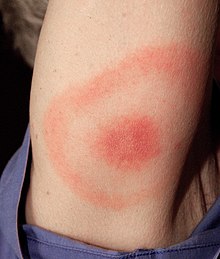Erythema
Erythema
Symptom defined as redness of the skin or mucous membranes mostly due to inflammation
Erythema (from Greek erythros 'red') is redness of the skin or mucous membranes, caused by hyperemia (increased blood flow) in superficial capillaries.[1] It occurs with any skin injury, infection, or inflammation. Examples of erythema not associated with pathology include nervous blushes.[2]
This article needs additional citations for verification. (December 2009) |
